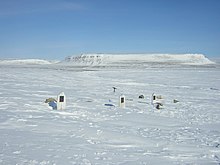Beechey Island
Location in the Canadian Arctic Archipelago | |
| Geography | |
|---|---|
| Location | Northern Canada |
| Coordinates | 74°43′N 091°51′W / 74.717°N 91.850°W |
| Archipelago | Queen Elizabeth Islands Canadian Arctic Archipelago |
| Area | 4.6 km2 (1.8 sq mi) |
| Highest elevation | 198 m (650 ft) |
| Administration | |
Canada | |
| Demographics | |
| Population | Uninhabited |
| Official name | Beechey Island Sites National Historic Sites of Canada |
| Designated | 1993 |
Beechey Island (Inuktitut Iluvialuit) is an island located in the Canadian Arctic Archipelago of Nunavut, Canada, in Wellington Channel. It is separated from the southwest corner of Devon Island by Barrow Strait.[1] Other features include Wellington Channel, Erebus Harbour,[2] and Terror Bay.
History
The first European visit to the island was in 1819, by Captain William Edward Parry. The island was named after the artist William Beechey (1753–1839) by his son Frederick William Beechey (1796–1856), who was then serving as Parry's lieutenant.[3]
It is the site of several very significant events in the history of Arctic exploration. In 1845, the British explorer Sir John Franklin, commanding a new but ill-fated search for the Northwest Passage aboard HMS Erebus and HMS Terror, chose the protected harbor of Beechey Island for his first winter encampment. The site was not discovered until 1851, when British and American search vessels anchored nearby.
In 1903, paying respect to Franklin, Norwegian explorer Roald Amundsen stopped at the island at the beginning of his successful voyage in search of the Northwest Passage.

In 1975, Beechey Island was declared a Territorial Historic Site by the government of the Northwest Territories. Since 1999, it has been part of the newly created Canadian territory of Nunavut.[4]
In 1993, five archaeological sites on Beechey Island and nearby Devon Island (the Franklin wintering camp of 1845-46, Northumberland House, the Devon Island site at Cape Riley, two message cairns, and the HMS Breadalbane National Historic Site) were designated as the Beechey Island Sites National Historic Site of Canada.[5]


The Beechey Island Graves

Beechey Island is best known for containing three graves of Franklin expedition members, which were first discovered in 1850 by seacher's for the lost Franklin expedition. The searchers found a large stone cairn, along with the graves of three of Franklin's crewmen -- Petty Officer John Torrington, Royal Marine Private William Braine, and Able Seaman John Hartnell—but no written record nor indication of where Franklin planned to sail the next season.
In 1850, Edward Belcher used the island as a base. There are memorials to Franklin and other polar explorers and sailors on the island, including Joseph René Bellot.[6]
In 1852, Commander Edward A. Inglefield arrived at Beechey, along with a physician Dr. Peter Sutherland. John Hartnell's grave was opened, damaging his coffin, and Hartnell's memorial plaque on the coffin lid was removed. During a later expedition, a searcher named Thomas Morgan died aboard the vessel North Star on May 22, 1854, and was buried alongside the three original Franklin crew members.
In the 1980s, during two separate expeditions to Beechey, Canadian forensic anthropologist Dr. Owen Beattie examined the three bodies and found them (externally) remarkably well-preserved. Autopsies determined that lung disease and lead poisoning were among the probable causes of death; the lead appeared to come from the thousands of lead-soldered tins of provisions with which the Franklin expedition had been supplied (although later studies would suggest that the unique water distillation system used by the ships was the major source of lead poisoning).[7]
In the 1990s, due to the deteriorating condition of the Beechey grave markers, all markers were replaced with bronze memorials.
In fiction
The explorers in Jules Verne's novel The Adventures of Captain Hatteras (in French: Voyages et aventures du capitaine Hatteras) visit Beechey Island. In addition, Clive Cussler's novel, Arctic Drift (2008), featured characters who would visit this island in the quest for Franklin's ships. The island is also mentioned in Dan Simmons' novel, The Terror.
References
- ^ "Beechy Island, Barrow Strait, Nunavut". mobilegeographics.com. Archived from the original on 2008-02-22. Retrieved 2008-04-22.
{{cite web}}: Unknown parameter|deadurl=ignored (|url-status=suggested) (help) - ^ "Beechy Island". google.com. Retrieved 2015-06-23.
- ^ Parry, W.E. (1821). Journal of a Voyage for the Discovery of a North-west Passage from the Atlantic to the Pacific: Performed in the Years 1819-20, in His Majesty's Ships Hecla and Griper, Under the Orders of William Edward Parry ; with an Appendix, Containing the Scientific and Other Observations. Vol. 1. John Murray. p. 51. Retrieved 2015-06-23.
- ^ Beechey Island. Canadian Register of Historic Places. Retrieved 29 October 2013.
- ^ Beechey Island Sites National Historic Site of Canada. Canadian Register of Historic Places. Retrieved 29 October 2013.
- ^ Brian D. Powell (2006). "The memorials on Beechey Island, Nunavut, Canada: an historical and pictorial survey". Polar Record. 42 (223): 325–333. doi:10.1017/S0032247406005596.
- ^ Preserved remains: discovery of the bodies
External links
- Beechey Island in the Atlas of Canada - Toporama; Natural Resources Canada


